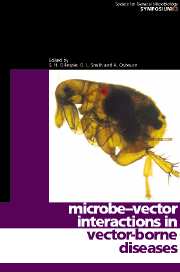Book contents
- Frontmatter
- Contents
- Contributors
- Editors' Preface
- 1 Vector-borne diseases
- 2 Evolution of tick-borne disease systems
- 3 Insect transmission of viruses
- 4 RNA-based immunity in insects
- 5 Specificity of Borrelia–tick vector relationships
- 6 Bunyavirus/mosquito interactions
- 7 How do mosquito vectors live with their viruses?
- 9 Vector competence
- 9 Environmental influences on arbovirus infections and vectors
- 10 Vector immunity
- 11 Transmission of plant viruses by nematodes
- 12 Wolbachia host–symbiont interactions
- 13 Pathogenic strategies of Anaplasma phagocytophilum, a unique bacterium that colonizes neutrophils
- 14 Interactions of Yersinia pestis with its flea vector that lead to the transmission of plague
- 15 Transgenic malaria
- 16 Vaccines targeting vectors
- Index
4 - RNA-based immunity in insects
Published online by Cambridge University Press: 06 July 2010
- Frontmatter
- Contents
- Contributors
- Editors' Preface
- 1 Vector-borne diseases
- 2 Evolution of tick-borne disease systems
- 3 Insect transmission of viruses
- 4 RNA-based immunity in insects
- 5 Specificity of Borrelia–tick vector relationships
- 6 Bunyavirus/mosquito interactions
- 7 How do mosquito vectors live with their viruses?
- 9 Vector competence
- 9 Environmental influences on arbovirus infections and vectors
- 10 Vector immunity
- 11 Transmission of plant viruses by nematodes
- 12 Wolbachia host–symbiont interactions
- 13 Pathogenic strategies of Anaplasma phagocytophilum, a unique bacterium that colonizes neutrophils
- 14 Interactions of Yersinia pestis with its flea vector that lead to the transmission of plague
- 15 Transgenic malaria
- 16 Vaccines targeting vectors
- Index
Summary
INTRODUCTION
Drosophila has been an excellent model for the mechanistic studies of innate immunity (Hoffmann, 2003). Recently, a new RNA-based antiviral immunity with features of both innate and adaptive immunities has been described in Drosophila and Anopheles cells (Li et al., 2002, 2004). This RNA-silencing-mediated immunity is characterized by the production of pathogen-derived, 22-nt small RNAs that serve as specificity determinants inside a multi-subunit complex. Similar to innate immunity, however, the new invertebrate antiviral response is capable of a rapid virus clearance in the absence of a virus-encoded suppressor of RNA silencing. The discovery of a new antiviral pathway in insects opens up the possibility of using this pathway to prevent transmission of vector-borne virus pathogens such as dengue and West Nile viruses.
THE RNA-SILENCING PATHWAY
Homology-dependent gene silencing was discovered in transgenic plants in a form of co-suppression between introduced transgenes or between a transgene and its homologous endogenous gene (Matzke et al., 1989; Napoli et al., 1990; Van der Krol et al., 1990). Similar gene-silencing phenomena have subsequently been described in a wide range of eukaryotic organisms such as fungi, worms, flies and mammals (Denli & Hannon, 2003; Fire et al., 1998). A generic term, RNA silencing (Ding, 2000), has been used to describe these related RNA-guided gene regulatory mechanisms variously termed post-transcriptional gene silencing (PTGS) in plants, quelling in fungi and RNA interference (RNAi) in animals.
A core feature of RNA silencing detected in all organisms is the production of 21–26-nt small RNAs from structured or double-stranded RNA (dsRNA) by the endoribonuclease Dicer (Bernstein et al., 2001; Hamilton et al., 2002; Hamilton & Baulcombe, 1999; Hammond et al., 2000; Zamore et al., 2000).
Information
- Type
- Chapter
- Information
- Microbe-vector Interactions in Vector-borne Diseases , pp. 63 - 74Publisher: Cambridge University PressPrint publication year: 2004
Accessibility standard: Unknown
Why this information is here
This section outlines the accessibility features of this content - including support for screen readers, full keyboard navigation and high-contrast display options. This may not be relevant for you.Accessibility Information
- 1
- Cited by
